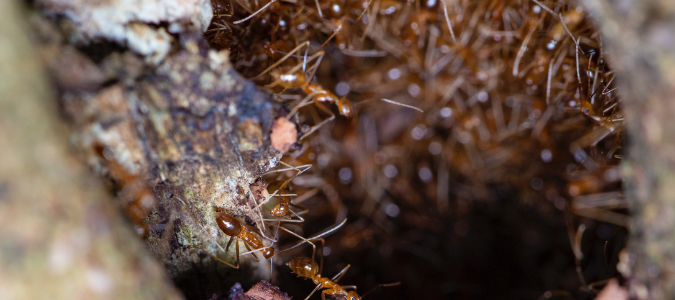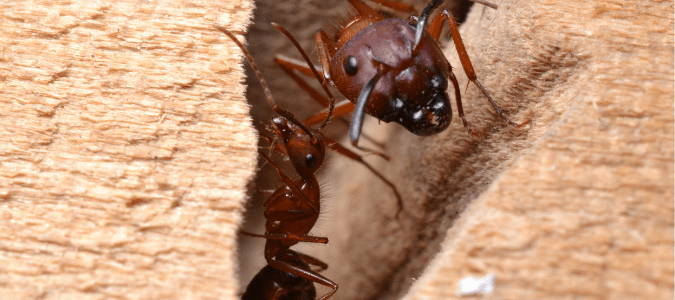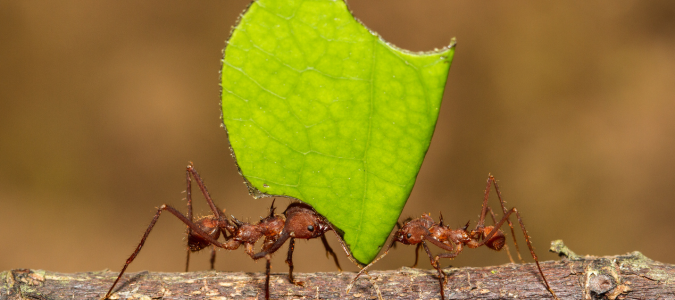Are ants invading your lawn? Ants are pesky nuisances, but there are ways you can manage their population to protect and preserve your lush lawn.
Ants in lawns are often an annoyance for homeowners during warmer months, particularly as nest-building ants may damage your lawn by building nests and tunnels in it. Some species can even bite or sting. Therefore, it’s important that you act when you see ants in your lawn.
What Conditions Attract Ants?
Ant species typically prefer lawns with dry, well-drained soil and low water-holding capacity. These conditions allow ants to easily build nests for food storage, colony defense and protection.
Ants are drawn to lawns that contain organic matter, such as dead leaves, grass clippings and debris. These materials give them the essential nutrition needed to survive and reproduce.
Finally, ants need water for survival. That’s why they are drawn to lawns with access to collected sources of moisture like sprinkler systems, irrigation systems and standing water that offer them sustenance. This shelter may include areas near sprinklers, irrigation systems and any other areas with poor drainage and standing water.
Keeping your lawn well-kept and debris-free is important in preventing ant populations. It’s also helpful to regularly mow or hire a lawn service professional to mow your lawn and clear away dead leaves and other accumulated organic material. This can also help with other pests, like mosquitoes.
Ants Are Common in Certain Grasses
You can find ants in various types of grass, but they tend to prefer taller ones with denser foliage, such as Bermuda and zoysia grass. These grasses provide an ideal place for ants to construct their nests while providing shelter and food sources.
Furthermore, thatch, dead grass and organic matter found within these grasses often attracts ants and provides them with an environment where they can easily survive.
How Homeowners Can Deter Ants
Ants can quickly become an eyesore if they invade your lawn, creating unsightly mounds or hills, which make enjoying outdoor spaces difficult. But, there are multiple strategies you can employ to deter them.
Mowing
Regularly mowing your lawn is one of the key strategies for deterring ants. By keeping your lawn healthy and regularly mowing it, you deprive ants of their preferred habitat. Remember that you should never remove more than one-third of the leaf tissue at one time.
Watering
Maintaining an adequate moisture balance in your lawn is another effective strategy against ants. Although they need water for survival, ants prefer dry soil, so ensuring your grass has enough moisture can make it less attractive. Be careful not to overwater your lawn since overdoing it could result in mold and fungus growth.
Fertilizing
Fertilizer will improve grass health, making it less vulnerable to infestation by these pesky insects. However, be careful not to over-fertilize, as this could create additional issues like excessive growth and thatch buildup. It’s best to work with lawn service experts for the best results when fertilizing lawns.
Dethatching
Dethatching can also help deter ants from your lawn by clearing away thatch accumulations on top of soil layers. This layer contains dead grass and other organic matter, which can attract them as nesting material for their colonies to reside within it. Removing it can reduce nest-building opportunities for ants. Dethatch your lawn effectively using a thatching rake or hiring a professional lawn care company.
Pest control experts offer effective ant control. Their knowledge and experience make them the go-to experts for quickly controlling these pesky insects.
Do Carpenter Ants Nest in the Ground?
Carpenter ants nest in wooden structures such as trees, logs and stumps for shelter. When their presence becomes an issue in your lawn, try to identify where the carpenter ants are nesting or congregating. They will usually be near decayed wood or damp areas.
Once carpenter ants in your lawn are identified and located, the next step is knowing how to control them. Any decayed wood and moisture sources in the area should also be removed to minimize the chance of future carpenter ant problems. Pest control professionals can identify and control carpenter ants efficiently.
What Do Carpenter Ants Look Like?
Carpenter ants, pictured above, tend to be larger than most ant species, measuring a quarter to a half of an inch long on average. Most are black in color, but some species can also feature reddish-brown or yellow hues.
You can identify carpenter ants by their distinctive heart-shaped heads and smooth, rounded thoraces, or the part of the body between their head and their abdomen. You’ll also notice their large mandibles used to carve tunnels for nesting inside wood surfaces.
Winged carpenter ants, known as swarmers, are often mistaken for termites; however, carpenter ants have narrow waists with bent antennae, while termites typically have broad waists with straight antennae.
Pest control professionals can identify a carpenter ant infestation, treat it and provide you with ongoing pest management services so you’re less likely to deal with a future infestation.
What To Know About Leafcutter Ants
A leafcutter ant is a small reddish-brown to black ant ranging from one-sixteenth of an inch to a half-inch long, sporting large and powerful mandibles that cut through vegetation such as leaves.
The name leafcutter comes from these ants’ characteristic behavior of cutting and transporting leaves back to their colony in an organized effort coordinated by their entire colony. They carry pieces of plants back to their nests to cultivate a fungus, their main food source.
The Life Cycle of Leafcutter Ants
The life cycle of leafcutter ants begins when the queen ants lay eggs which hatch into larvae that are cared for by worker ants until eventually emerging as adult ants.
Newly emerged female ants are all responsible for caring for the colony and taking steps to maintain it, including collecting food for processing, building their nest and looking after the queens and the offspring of these queens.
Over time, colonies produce male ants and new queen ants who mate, leading them to start new colonies and beginning the cycle all over again.
The Bottom Line
There are various solutions available to control and prevent ants on your lawn. Finding one that best meets the requirements for you and your lawn is important.
Maintaining a healthy lawn through regular mowing and fertilization can help eliminate elements of your lawn that attract ants. Pest control experts can take controlling ant populations off your hands so you can get back to enjoying time outside again.
ABC Can Control and Prevent Ants
Dealing with an ant problem can be extremely frustrating. Instead of trying to prevent or control ants on your own, contact ABC Home & Commercial Services. Our highly trained pest control professionals will create a custom treatment plan.



